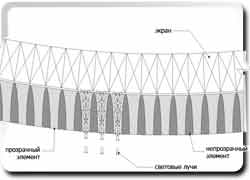 Introduce you to new technology advertising screens, developed a reader of our project.
Introduce you to new technology advertising screens, developed a reader of our project. Feature of the device is that the screen is a cylinder on whose surface the displayed image to visually is always facing frontally to the viewer, regardless of its location or movement. That is, the angle of a full review of the screen is 360.
Picture "view escorts" spectator, when he passed her. In this case, the image itself can be static or animated.
Attached is the author's patented manufacturing technology of the screens. At this point the author is actively seeking co-investors, but, I suppose, from free advice, too, will not give up

So patent RU 2375762 C1
The device is a cylinder, inside which there are more identical to each other screens (eg 3), as shown in Figure 1 (top view). The display is a matrix that carries the image. Behind the matrix is a spotlight shining through the matrix at the viewer. In essence, this part of the mechanism is akin to an ordinary slide projector.
Before the matrix are special "blinds" going vertical in the entire height of the screen and perpendicular to it. The width of each element is minimal, and the length is several times greater than the distance between them, as shown in Figure 2 (a vertical incision). These elements acted as a tracer layer filtering angle so that the image becomes available for perception only when there is frontal or nearly frontal in front of the audience. The whole construction is very rapidly rotates around its own axis, which we have at any point around the cylinder of the same number of hits in the field of view of open space displays and we have a relatively stable picture.
The walls of the tracer elements must be covered with light-absorbing material, so that was no reflection of light emanating from the screen. There is a second version of the filtration angle: the elements of the filtering layer is made of transparent material, and represent Fauconnier, as shown in Figure 3. But the principle remains the same: the screen remains visible spectator only in that short time when there is frontal in front of the audience. Decrease in the total luminosity of the moment at each point of the surrounding space, which arises as a result of downtime during the turnover of the screen is offset by the power build-up and concentration of light and brightness of the light rays in turn smoothed extremely short duration of contact with light in the eye, when building up speed device cycle appearance and disappearance of light rays is minimal perceived, ultimately striving to effect a permanent balanced glow, similar to a Vertical Tube TV screens and monitors. When using 3 screens and 10 revolutions per second, we get the vertical refresh the image at 30Hz, but at 30 is respectively 90.
The increasing complexity of technology is to manage the matrix, transmissive and forming an image. According to the principle of digital projection matrix is divided into pixels and generates the color of each of them individually, adjusting the number and range of passing it through the light. For example, each pixel has 3 holes, with colored glass in each, forming a model of RGB, and the amount of each component is governed by compression / expansion of the aperture, which determines the amount of transmitted light.Or use special photorefractive prisms that the degree of rotation to pass through these beams of light will create a particular color of the beam at the output due to its ability tsvetorazlozheniya. On the basis of this mechanism is formed by frame images.